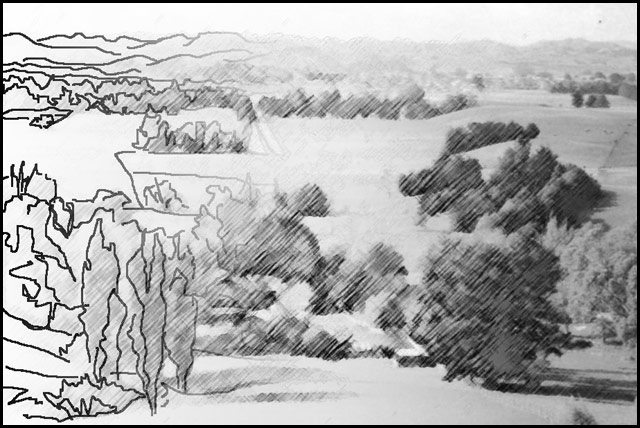(Originally posted on LiveJournal)
Recently, I was reading the first chapter of a friend’s current work-in-progress, in order to give her notes on it.
So, let me say that first off, I did like her story. She is a good storyteller.
But something about the chapter nagged at me, because the descriptions felt flat. On the one hand, it was clear to me that she has a sure vision of her characters and setting. And the chapter was not lacking in the details. But on the other hand, something just wasn’t working.
 When I went back through the pages, I realized that it was because just about all the description was carried by a “adjective plus noun” structure. Almost all the key nouns were tagged with adjectives or adjectival conjunctions. The constant repetition of this formula flattened out the effect of the details.
When I went back through the pages, I realized that it was because just about all the description was carried by a “adjective plus noun” structure. Almost all the key nouns were tagged with adjectives or adjectival conjunctions. The constant repetition of this formula flattened out the effect of the details.
Secondly, she didn’t give any over-all descriptions to describe the general impact of the setting. So instead of giving us an initial impact of “a richly appointed office, gleaming with brass, glass and polished leather” (the effect I think she was going for), she gave the details of specific items as her character dealt with them. The sum of the details was not greater than the total, instead, it was considerably less.
After writing up the notes for my friend, I turned to working on some revisions to my own work, based off notes from a critique group. Their principal note was that I had included too many “new” words (this is my fantasy, The Ring of Adonel, we’re talking about) without hinting at their meaning. I’d left too many of them to be guessed at in context – and mostly, their guesses were indeed correct. Even though their guesses were on the mark, I realized the intellectual anxiety they had in tracking the meanings would be a drag on their reading. So I had to address it.
As I worked on it, trying to weave in definitions of my “new words” without using the Hammer of Exposition, I was also paying attention to how I was building my descriptions. The critique group had praised this aspect of my writing. So I was trying to be objective and figure out what I was doing (right) that my friend was not.
One thing I noticed is that I like to try and establish a general sense of place first. The general atmosphere, and if a character is present, how that character is reacting to the setting. After that, every description serves to reinforce the over-all sense, often by contrast. The opening sequence of the novel is set in the quiet of pre-dawn, outside of residences. But to enhance the sense of quiet, many of the descriptions are of small sounds – the sorts of things one would not notice during daytime when many people are out and about. Things like the sound of soft-soled boots moving on stone (which is a really soft sound, as I learned back when I frequently wore moccasins).
I also tried to vary from the “adjective plus noun” descriptions. Oh, they are there. I don’t think you can entirely get away from them in the English language. But some of them I also tried to turn into noun / verb constructions. Metaphors and similes were also tools I put to use. But it is all laid in on some bones of plain prose. Grass is just grass. Stones are just stones. It is the blend of bare words with loaded description that creates the mix.
Now, I would be the first to admit that I am capable of some deeply purple prose. I’ve certainly gotten better at toning down the overly-rich descriptions. After all, I don’t want to put my readers into an insulin shock from too much description. But after going over my friend’s draft, I’ve come to realize that bare bones with no meat isn’t the only problem alternative to “too much cake”: you could also have a “safe” amount of cake that had turned to dry crumbs and fallen apart.
The point of this lesson? Gee, this writing stuff is hard.
😀
Comments
sartorias – Oct. 22nd, 2009
I’ve found that sometimes description (and exposition) lapses into a general voice, or reporter’s tone, separate from the voice of the rest of the narrative–which can cause the eye to skim.
But getting outside of all these things enough to see one’s own efforts is a toughie!
scribblerworks – Oct. 22nd, 2009
I agree that getting to that objective point isn’t easy. I had to let a couple of weeks go by before I tackled the groups notes. Even though I could see their points at the time of our meeting, I couldn’t sit down with the manuscript right away for the revisions.
It is a lot of work to get the exposition woven into the flow of the story. But I’m keen to avoid those sudden stops for encyclopedia-type exposition of things, places and events.
corrinalaw – Oct. 23rd, 2009
A good friend once told me that “setting is character.” Meaning that the setting is unique to however the character perceives the world. It took that to get through to me and I stopped trying to put the characters in “space” as it were and instead just settled far deeper in POV so not only did the character see what was around them but they had an emotional reaction to it as well.
It’s not just a “richly appointed office,” it becomes a richly appointed office like one she should have. Or one she thinks she’ll never deserve. Or one that she’s been in many times and always hates it.
Again, basic, and probably stuff you already know but I have to keep reminding myself of this often as I write.
scribblerworks – Oct. 23rd, 2009
Exactly. My feeling about it is that the reader rides on a character’s reaction to the environment. So the description needs to assist that.
But the author paying attention is the first order of business.


